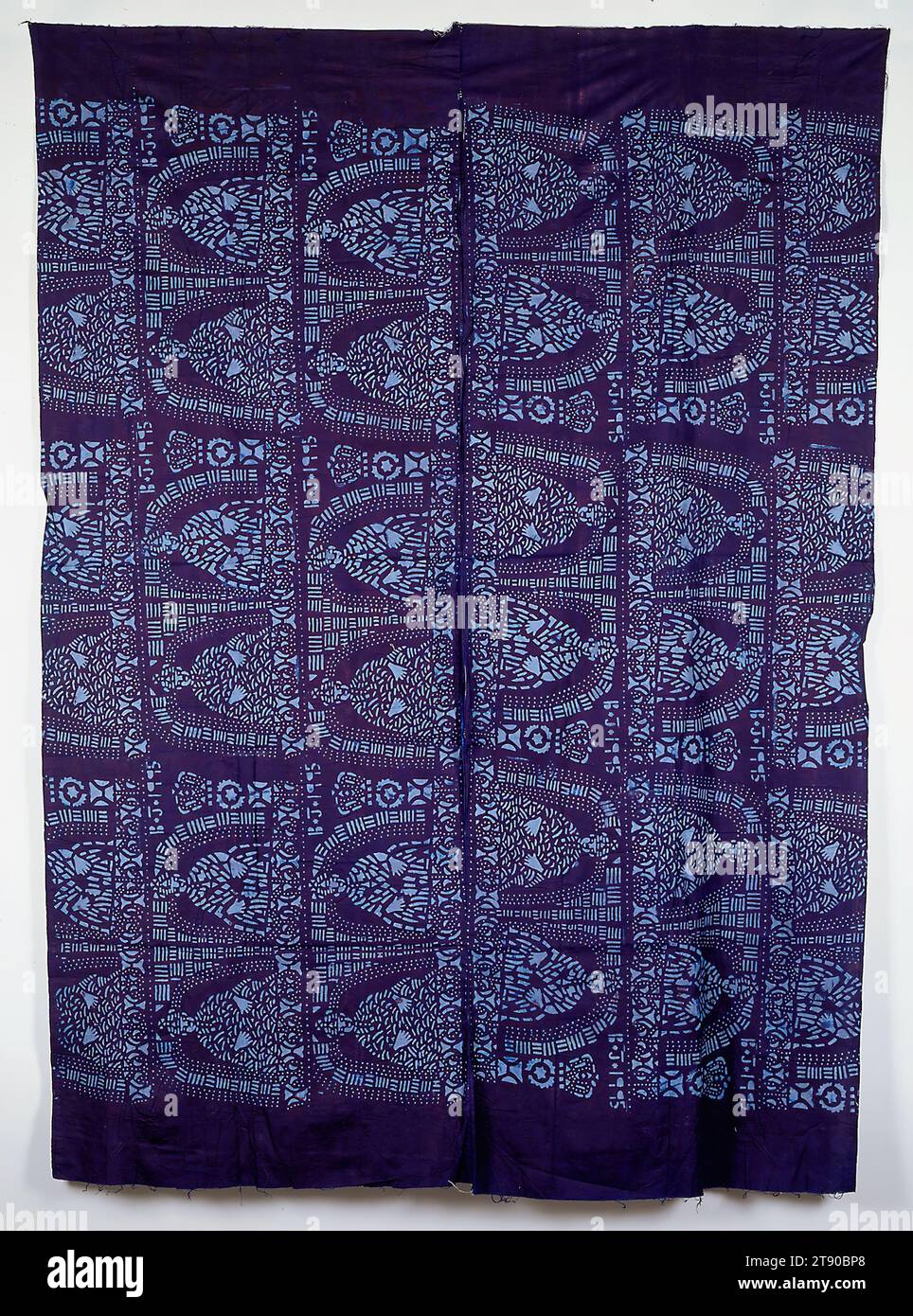Stitched resist dye techniques Stock Photos and Images
(2)See stitched resist dye techniques stock video clipsStitched resist dye techniques Stock Photos and Images
 Woman's skirt, 20th century, 33 1/2 x 15 11/16 in. (85.09 x 39.85 cm) (without fringe), Raffia; oblique interlacing, resist tie-dye and stitched-resist dye, Côte d'Ivoire, 20th century, The Dida of Côte d'Ivoire produce some of the most striking and unique textiles found in Sub-Saharan Africa. Using the unusual technique of oblique interlacing, Dida artisans painstakingly plait up to 1,500 strands of raffia into a long, narrow tubular form. When the garment is completed, it is embellished with intricate, bound and stitched-resist dye techniques in repeating patterns of rectangles, circles Stock Photohttps://www.alamy.com/image-license-details/?v=1https://www.alamy.com/womans-skirt-20th-century-33-12-x-15-1116-in-8509-x-3985-cm-without-fringe-raffia-oblique-interlacing-resist-tie-dye-and-stitched-resist-dye-cte-divoire-20th-century-the-dida-of-cte-divoire-produce-some-of-the-most-striking-and-unique-textiles-found-in-sub-saharan-africa-using-the-unusual-technique-of-oblique-interlacing-dida-artisans-painstakingly-plait-up-to-1500-strands-of-raffia-into-a-long-narrow-tubular-form-when-the-garment-is-completed-it-is-embellished-with-intricate-bound-and-stitched-resist-dye-techniques-in-repeating-patterns-of-rectangles-circles-image573485232.html
Woman's skirt, 20th century, 33 1/2 x 15 11/16 in. (85.09 x 39.85 cm) (without fringe), Raffia; oblique interlacing, resist tie-dye and stitched-resist dye, Côte d'Ivoire, 20th century, The Dida of Côte d'Ivoire produce some of the most striking and unique textiles found in Sub-Saharan Africa. Using the unusual technique of oblique interlacing, Dida artisans painstakingly plait up to 1,500 strands of raffia into a long, narrow tubular form. When the garment is completed, it is embellished with intricate, bound and stitched-resist dye techniques in repeating patterns of rectangles, circles Stock Photohttps://www.alamy.com/image-license-details/?v=1https://www.alamy.com/womans-skirt-20th-century-33-12-x-15-1116-in-8509-x-3985-cm-without-fringe-raffia-oblique-interlacing-resist-tie-dye-and-stitched-resist-dye-cte-divoire-20th-century-the-dida-of-cte-divoire-produce-some-of-the-most-striking-and-unique-textiles-found-in-sub-saharan-africa-using-the-unusual-technique-of-oblique-interlacing-dida-artisans-painstakingly-plait-up-to-1500-strands-of-raffia-into-a-long-narrow-tubular-form-when-the-garment-is-completed-it-is-embellished-with-intricate-bound-and-stitched-resist-dye-techniques-in-repeating-patterns-of-rectangles-circles-image573485232.htmlRM2T90E7C–Woman's skirt, 20th century, 33 1/2 x 15 11/16 in. (85.09 x 39.85 cm) (without fringe), Raffia; oblique interlacing, resist tie-dye and stitched-resist dye, Côte d'Ivoire, 20th century, The Dida of Côte d'Ivoire produce some of the most striking and unique textiles found in Sub-Saharan Africa. Using the unusual technique of oblique interlacing, Dida artisans painstakingly plait up to 1,500 strands of raffia into a long, narrow tubular form. When the garment is completed, it is embellished with intricate, bound and stitched-resist dye techniques in repeating patterns of rectangles, circles
 Woman's wrapper, 1995, 86 1/2 x 64 3/4 in. (219.71 x 164.47 cm), Cotton; stencilled, starch-resist patterning (àdire eleko); dyed, Nigeria, 20th century, Àdire isa popular form of surface ornamentation in the Yoruba culture in which designs are created by resist-dye techniques. The method of resist can take several forms; tie dye, stitched patterning, hand painting and stenciling are all commonly used to develop intricate patterns of pale blue on a deep indigo ground Stock Photohttps://www.alamy.com/image-license-details/?v=1https://www.alamy.com/womans-wrapper-1995-86-12-x-64-34-in-21971-x-16447-cm-cotton-stencilled-starch-resist-patterning-dire-eleko-dyed-nigeria-20th-century-dire-isa-popular-form-of-surface-ornamentation-in-the-yoruba-culture-in-which-designs-are-created-by-resist-dye-techniques-the-method-of-resist-can-take-several-forms-tie-dye-stitched-patterning-hand-painting-and-stenciling-are-all-commonly-used-to-develop-intricate-patterns-of-pale-blue-on-a-deep-indigo-ground-image573483296.html
Woman's wrapper, 1995, 86 1/2 x 64 3/4 in. (219.71 x 164.47 cm), Cotton; stencilled, starch-resist patterning (àdire eleko); dyed, Nigeria, 20th century, Àdire isa popular form of surface ornamentation in the Yoruba culture in which designs are created by resist-dye techniques. The method of resist can take several forms; tie dye, stitched patterning, hand painting and stenciling are all commonly used to develop intricate patterns of pale blue on a deep indigo ground Stock Photohttps://www.alamy.com/image-license-details/?v=1https://www.alamy.com/womans-wrapper-1995-86-12-x-64-34-in-21971-x-16447-cm-cotton-stencilled-starch-resist-patterning-dire-eleko-dyed-nigeria-20th-century-dire-isa-popular-form-of-surface-ornamentation-in-the-yoruba-culture-in-which-designs-are-created-by-resist-dye-techniques-the-method-of-resist-can-take-several-forms-tie-dye-stitched-patterning-hand-painting-and-stenciling-are-all-commonly-used-to-develop-intricate-patterns-of-pale-blue-on-a-deep-indigo-ground-image573483296.htmlRM2T90BP8–Woman's wrapper, 1995, 86 1/2 x 64 3/4 in. (219.71 x 164.47 cm), Cotton; stencilled, starch-resist patterning (àdire eleko); dyed, Nigeria, 20th century, Àdire isa popular form of surface ornamentation in the Yoruba culture in which designs are created by resist-dye techniques. The method of resist can take several forms; tie dye, stitched patterning, hand painting and stenciling are all commonly used to develop intricate patterns of pale blue on a deep indigo ground